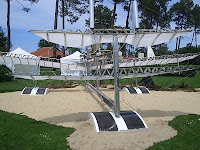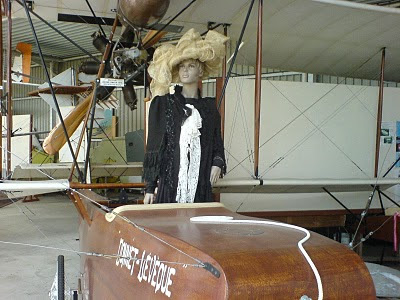Now, in spite of claims to the contrary, we found that there is no bus from Arcachon to Biscarosse, so we would have to take a taxi. The receptionist at the hotel kindly offered to take us in her own car if we could wait until she got off her shift later in the day, but we (I) were anxious to get there early so as not to miss anything, so off we went.
On the way I glimpsed something through the woods that looked like an airfield. I later had it confirmed that this was Base Aérienne 120 at Cazaux, a military airfield founded in 1914.
Presently we arrived in Biscarosse, « Capitale de l’Hydraviation ». The town was clearly proud of its aviation heritage and had streets and places named for French aviation heroes. The taxi dropped us off just outside the main gates to the airshow area. It was windy, overcast and not very warm, but what the heck, tickets for two and then in. Past a group of market stands with various parafernalia we found a gaggle of ultralight seaplanes with larger seaplanes beyond.
While we were among the early arrivals the PA system was already running full tilt blasting 80:s hits interfoliated by information about the day’s activities and exhortations to sign up for « baptêmes de l’air ». Indeed the biggest planes soon powered up, rolled down the ramp into the water (me staring and eventually figuring out how the landing gear retracted into the floats) and started boarding people. The ultralights also started into the water and then up into the air.
However, the really big aircraft, the Catalina and the Do 24 hadn’t turned up yet (and the latter never did while we were there), so we strolled around and looked at the things on the ground. Off to a side was a very sandy beach with a Bell 47G that also took people up for their air baptisms. There were plenty of market stands, some purely commercial, others promoting various aviation organisations and charities and, of course offering things to buy in order to support said organisations. We found some very earnest but disappointing graphic history books (as generalised from graphic novels) on the origins of manned flight. I suspect the stilted look comes from basing the drawings on photographs while not having a good internal feeling for the subject.
There was an exhibition hall displaying (award-winning) philatelistic collections on the theme of aviation heroes. The hall was also covered with children’s drawings of seaplanes; children had also—with great creativity and innovative use of materials (grass, rubber, tin foil, etc)—created three-dimensional representations of seaplanes, that now hung from poles outside the hall. It seems that Biscarosse celebrates its heritage not only in street names, but also in the education of the local children.

The label on the side seems to say A-370, which type does not actually exist; on the other hand, at least eight different Airbusses have used the serial F-WWAS.
We dove into our lunch, while being force-fed 80s disco. (Well, to be perfectly honest I tend to have a soft spot for it and am not all that tired of even Rick Astley, but Honeybuns made grimaces at the music.)
Now was the time to visit the seaplane museum, just a short walk up the beach. I was overjoyed to find right in the front of the museum not one but two replicas of Fabre’s « Hydravion », it being the reason for the celebration.
 |  |
| Flyersteam, a replica in period materials. | Fabre 2010, a replica in modern materials. |
I clambered around the aircraft, which were absolutely brilliant examples of how early aircraft were operated. In particular I finally got to see gauchissement, wing warping, in action. I had assumed that a set of wires would pull at the trailing edge of the wing, but as you can see demonstrated by my beautiful assistant the control wires pull at the post through the (evidently quite elastic) wing spar and disconcertingly twist the entire wing (note also that on this aircraft it is the pedals that are used for banking, rather than the stick as became a universal standard at about this time):
(And here is a demonstration of the rudder and elevator control, much more direct.)
I would not have been quite as cavalier about testing the flight controls and pulling on the wires if I’d realised that the replicas were not just static models, but were intended to be flight tested on the Sunday, as a suitable climax to the meeting. But, I watched the planes being carefully tested and adjusted just after I’d left them, so I’m sure this was not my fault:

Another thing I only realised when I’d gotten back to my computer was that both the replicas were based on the form of the Hydravion as shown by the model at the museum:

Compare with this picture, presumed from that first flight on 1910-03-28. You see that the rudders are located below the wings and elevator control is performed with a single tiller.

Kenneth Munson notes in Flying Boats and Seaplanes since 1910 that Fabre modified the aircraft, eventually moving the rudders “to their final position in the warp-wire struts beneath the main wings”, which is where we see them in the photograph above. This would imply that the replicas are in the original configuration, and the photographs I have are in fact all from the flights made in Monaco in 1911, in spite of the captions at the Monash web site that show an identical aircraft at what is said to be both the flights made at La Mède and Monaco a year later. What a surprise that an Internet source would turn out to be unreliable…
(One could also suggest that perhaps the replica-builders should have gone for the final and presumably more effective configuration. Not that it didn’t eventually crash too…)
Anyway, after having played with the replicas we entered the museum. It was quite pleasant and there was a lot to look at, but I noted that one really had to know what one was looking at to make sense of the exhibits which were for the most part very sketchily labelled. As we were exiting the museum I saw the stand with the sign “Please return your guidebook here.” D’oh! (They could have just handed us a guidebook when they were checking our tickets, one thinks.)
A bit snobbishly I noted that “museum quality model” apparently does not necessarily mean a lot in terms of finish and detailing. Still, there was plenty to look at and be inspired by. I was a bit disappointed that the museum shop was so lacking in seaplane models—just a couple of boxes with the Heller Canadair CL-215, which is nice enough, but there are so many others.
A completely new exhibition of full-scale seaplanes (together with scores more of child-produced models) was housed in a glass-walled hangar across the yard.

A Donnet-Lévêque, the world’s first flying boat. The flying suit is authentic and documented in contemporary photographs.
Eventually we returned to the flight area and decided to have a cuppa in one of the food stands. Honeybuns’s cocoa sent her off on a high such as only French chocolate can do, for the rest of the day. (Forget about Belgian or Swiss chocolate, France is where it’s at.) We noted that the disco seemed to have let off and as we were in lee and there was momentarily a bit of sun, we just sat there and felt good. Then, the Breitling Wingwalkers buzzed in and did a programme. I realised we had seen the wingwalkers on the ground earlier in their black and orange uniforms. Well, I had. Those were quite tight-fitting black and orange uniforms. And wingwalking requires you to be very fit. And there were two of them. Hm, moving right long: We thought it was a bit lazy of the speaker not to have any comments on the proceedings, but it was a good show. As they left, we thought about leaving too and got up. When we moved we got in range of the PA system again and realised that the speaker had been relentlessly going on all the time and he was now explaining the rest of the programme for the day. There was actually going to be an entire hour of antics (and antiques) in the air (but which my dinky camera can’t do justice to, so you will just have to imagine it). The Catalina that had flown in during the day took off for several circuits, with floats up and down, lights on etc. I realised that the Catalina was equipped with the same Pratt & Whitney Twin Wasp engines as the C-47, so being a very familiar sound. And indeed, as soon as the Catalina had landed we were visited by a C-47 with a most interesting scheme with invasion stripes over natural metal.
This was followed by La Patrouille REVA, flying three Rutan VariEzes. I’d never seen a VariEze do aerobatics before, but I wasn’t surprised to find that they did it very, very well.
The following performances by an Extra 300 and a Sukhoi Su-31 tearing around the air, hanging off their mighty engines, was impressive, but not as elegant in my opinion.
For the aviators, there would be dinner and dance later on, but we decided to call it a day. I bought a Fouga Magister T-shirt and noted that the Swedish presence clearly was much appreciated:
 |  |  |
Our kindly receptionist had supplied us with telephone numbers to local taxi companies and soon a very friendly taxi driver picked us up and drove us back, this time along the scenic route, which turned out to be just as fast as the motorway we’d arrived by, but indeed was considerably more scenic, in particular when we passed La Dune du Pyla, a huge sand dune by the beach.
I even managed quite a bit of conversation with the driver. Oui, on parle français ici !




2 comments:
I mailed this to you a few mins. ago, before checking here; but now I'll post the quote & link here as well.
----
The SCI-FI AIR SHOW’s purpose is to preserve and promote the rich and varied history of Sci-Fi/fantasy vehicles. Through display and education we seek to celebrate the classic design and beauty of these ships and the rich imaginations that created them. When the cameras stopped rolling, many of these proud old ships were lost and forgotten. Please join us in working to keep these rare and beautiful birds soaring!
Brilliant! I was left gaping for several minutes, not knowing that full-scale models of these spacecraft existed and then I read the detailed descriptions. :-)
Post a Comment